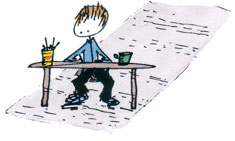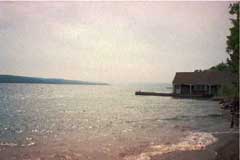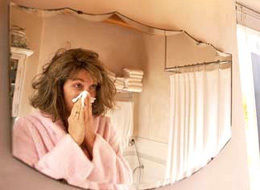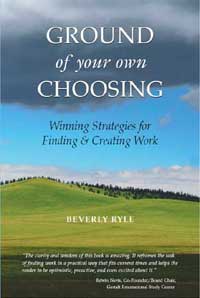Tag
Brake to Recharge
 It seems like just about everyone I've talked to lately has commented about the accelerated pace of their lives.
It seems like just about everyone I've talked to lately has commented about the accelerated pace of their lives.
I hear it in ubiquitous phrases, like, "I've just been so busy, flat out, swamped, etc."
I feel it in the genuine regret I experience when I have to say no to something I want to do or find myself postponing being with a friend or colleague whose company I enjoy because I'm booked solid.
Although it's comforting to know I'm not alone, it's also alarming to realize that the goal of living a more balanced rhythm is eluding so many of us.
Could over-scheduling be like global warming, sneaking up on us by degrees and threatening our well-being?
Fortunately, last October, after a period of trying to normalize my overextendedness resulted in failure, I became painfully aware that I was driving myself too hard.
Skaneateles Takeaways
 Because October's post spoke to so many readers about the need for renewal, and because the upcoming holiday season offers the opportunity for time off to regroup for the new year, I have decided to share my takeaways from this year's trip to Skaneateles sooner than I had originally planned.
Because October's post spoke to so many readers about the need for renewal, and because the upcoming holiday season offers the opportunity for time off to regroup for the new year, I have decided to share my takeaways from this year's trip to Skaneateles sooner than I had originally planned.
My time at the lake this year was about being in the here and now. I try to do this at home, but being away frames it differently.
There's the packing and the unpacking, the seven hour trip there and back, the joy of arriving and the sadness of leaving. Going to the same place every year has sharpened my awareness of these dichotomies, and I know the alternating rhythm well enough that sway with it immediately.
Skaneateles Redux
 Note: this is a reprint of a newsletter column which appeared November 10, 2006. I really am in Skaneateles at the moment, and I'm looking forward to sharing the strategic lessons I learn this year with you in a later post. Bev.
Note: this is a reprint of a newsletter column which appeared November 10, 2006. I really am in Skaneateles at the moment, and I'm looking forward to sharing the strategic lessons I learn this year with you in a later post. Bev.
I'm sitting in the cozy living room of a house perched on the side of a steep hill overlooking Skaneateles Lake. (Pronounced "skinny-atlas," it's the second easternmost of New York's Finger Lakes). From my comfortable wide-armed mission chair I have a 180-degree view of the calm, glistening water through the windows that surround me on three sides. There is no sound except for the gentle lapping of the waves, the chatter of a kingfisher, and the clicking of the keys on my computer.
I am on retreat from the office, from my complicated schedule, from being flat out.
My decision to come here was a strategic decision, and I use the word "strategic" intentionally for three reasons.
Staying Home
 A 2005 article in the London Evening Standard about overwhelmed working women advised them “not to struggle into work when ill but to stay at home and rest.” Likewise, the November 2009 issue of Working Women magazine cautioned readers against “dragging [their] fever-ridden [bodies] into the office.”
A 2005 article in the London Evening Standard about overwhelmed working women advised them “not to struggle into work when ill but to stay at home and rest.” Likewise, the November 2009 issue of Working Women magazine cautioned readers against “dragging [their] fever-ridden [bodies] into the office.”
Under ordinary circumstances, this would be simply a matter of common sense, but the economic slowdown we are experiencing has eroded our sense of work security and had the effect of making people fearful that their absence from work, even for a day or two, could have disastrous consequences. In a new context, this simple advice deserves a closer look.
In Crazy Busy, author and physician Edward Hallowell talks about having to go to work regardless of your physical condition as if it were something that belongs to the past, like the experience of the lower classes as described in Dickens’s novels. But is it?
Paper Calendar
So many of us are trying to manage the busy-ness of the four week sprint between Thanksgiving and Christmas with the aid of technology. Yet I’m beginning to wonder if electronic calendars really assure productivity, or if they simply create the illusion that we can do more with the twenty-four hours that make up a day than our ancestors, who marked the passing of time with pillars of stone or sundials, did.
We need to meet with a client, or attend a board meeting, or arrange an evening with our spouse, so we click to see if there is room in the little window that pops up. If there is, we book it.
What usually doesn’t happen in the few seconds it takes to add yet another commitment to our lives is any real thought given to the needs of our body, mind and spirit.
I’ll Take Anything
When you tell people you live on Cape Cod, they often tell you you're lucky, and for three-fourths of the year, they're right.
What they don't know—and you do, after you've lived here long enough to experience a few Aprils when the daffodils seem to shiver in the cold rain and the forsythia refuses to bloom—that there is no spring. Or, to be more precise, what little of it there is comes so late that it imperceptibly merges with summer!
I'm more dismayed by the sunless days and lack of color this year than I have been in the past, and I think it's because of the bleakness of the economic landscape.
The truth is, both here on the outer Cape where I live and in the business world we all occupy, things look pretty brown right now. You have to be very attentive to notice that the willow branches have a slight yellow tinge against the gray, gloomy sky, just as you have to look carefully to see any glimmer of hope in these dark economic times.
Skaneateles
 I'm sitting in the cozy living room of a house perched on the side of a steep hill overlooking Skaneateles Lake. (Pronounced "skinny-atlas", it's the second easternmost of New York's Finger Lakes).
I'm sitting in the cozy living room of a house perched on the side of a steep hill overlooking Skaneateles Lake. (Pronounced "skinny-atlas", it's the second easternmost of New York's Finger Lakes).
From my comfortable wide-armed mission chair I have a 180-degree view of the calm, glistening water through the windows that surround me on three sides. There is no sound except for the gentle lapping of the waves, the chatter of a kingfisher, and the clicking of the keys on my computer.
I am on retreat from the office, from my complicated schedule, from being flat out.
My decision to come here was a strategic decision, and I use the word "strategic" intentionally for three reasons.
First, because one of the best things I can do for my clients (and myself) is to leave them periodically.
Second, because how I "lead" in my personal life is just as much a function of being a leader as how I run my business.
And lastly, I have to use the same care and diligence in planning renewal time as I do in planning any other element of my professional life. It's the only way I can keep it from slipping away from me.
Bleeding Work
 Today you enter the Boott Cotton Mill at the Lowell National Historical Park the same way that the thousands who worked there from 1835 through the early twentieth century did—through the white wood Gothic-arched doorway leading to a five-story spiral staircase enclosed in a vertical brick tower.
Today you enter the Boott Cotton Mill at the Lowell National Historical Park the same way that the thousands who worked there from 1835 through the early twentieth century did—through the white wood Gothic-arched doorway leading to a five-story spiral staircase enclosed in a vertical brick tower.
Although the stairs are made of stone, they are worn by the steps of the countless men, women and children who passed up and down them for almost a century.
They went to work when the bell rang at first light and left twelve to fourteen hours later, depending on the season, when the bell rang again to mark the end of the day. It was grueling work, and many died.
Breaking the Pattern of Overwork
 Unlike the frog who failed to realize he was in boiling water until it was too late, I fortunately became aware that I was chronically tired before the downward spiral this form of self-abuse inevitably triggers had taken me to the danger point.
Unlike the frog who failed to realize he was in boiling water until it was too late, I fortunately became aware that I was chronically tired before the downward spiral this form of self-abuse inevitably triggers had taken me to the danger point.
The breakthrough came when I participated in a leadership program with Joan Goldsmith, where I was introduced to the self-assessment survey in the book Tired of being Tired: Rescue, Repair, Rejuvenate by Jesse Hanley and Nancy Deville (for details, see last month’s column).
Tired and Overworked
 It's 3:30 in the afternoon and I am writing this with a large pot of tea beside me. It sounds very civilized, except that I made the tea because I am tired, and I felt compelled to work on this column. Instead of taking a nap, I chose to take a stimulant and fall back into my pattern of overwork.
It's 3:30 in the afternoon and I am writing this with a large pot of tea beside me. It sounds very civilized, except that I made the tea because I am tired, and I felt compelled to work on this column. Instead of taking a nap, I chose to take a stimulant and fall back into my pattern of overwork.
The good news is that I rarely do this any more, and when I do I am conscious of the choice I am making. For years, I just pushed through my fatigue and remained a victim of my own calendar and “to do” lists with absolutely no awareness of how damaging being a supercharged performer was both to my professional life and to my health.






